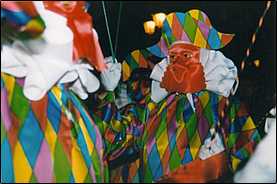Dressing
for Carnival in Italy
By
Janice Clark
Carnival is celebrated all around the world, notably in Brazil, Trinidad, Switzerland, Italy and the US. The history, folklore, foods, music, customs, costumes, parades, balls and pageantry have become part of the local culture.
The observance of a "Carnival" before the Lenten period (a Christian symbolic penitence from Ash Wednesday to Easter) originated in the middle of the 2nd century in Rome when the Fast of the 40 days of Lent was preceded by a feast of several days. Participants put on masks, clothed themselves like spectres and gave themselves up to Bacchus and Venus.
 |
| photo by Michel Pichard |
The name carnival is derived from the Latin "Caro" or "Carnis" for "flesh" and "vale" for "farewell". The modern carnival is more or less the Saturnalia (ancient Roman festival held in December for the celebration of the winter solstice) of the Christian Romans who could not forget their pagan festivals. From Rome, the celebration spread to other European countries and finally to America.
Italy, as mentioned, is the birthplace of the Carnival tradition. Northern Italian carnival traditions are celebrated on Shrove Tuesday in the towns and villages in the Ticino region. In a tradition dating back to the 1860's, a meal of rice is served outside from a huge vat and enjoyed in a festive community atmosphere.
In Venice, the festivities begin about 2 weeks before Ash Wednesday. Dress style most frequently reflects the elegance of the 17th and 18th century nobility. Typically several distinctive historical characters appear which make fun of everyday life, with Venetian humor and self-irony.
One of the most well-known characters is the witty Harlequin, who first appeared in 1572, dressed in a colorful patched outfit. Harlequin is a poor character, dressed in remnants of richer costumes. He began as a naïve and simple character, later evolving into a more sophisticated one who outwits the arrogant and greedy people with whom he comes into contact. He is somewhat anti-establishment and always hungry and poor. However, in the 18th century, when the character lost it's wit, poverty and fantasy element.
Pantaloon (originally Pantalone), the Venetian merchant, is rich, greedy and naïve. He's elevated himself from merchant to nobleman and always has to deal with people trying to take his gold from him, while losing against bad luck. At times, he can be pleasant and trusting, but on the other hand he's selfish when it comes to money. Old but athletic, Pantaloon plays the ideal counterpart to the Harlequin, who is always without money or the Zanni, the poor immigrant.
Pulcinella is another witty character. Philosophical, eternally melancholic, and dreamer, has a spirit all his own. Without stress or despair, he maintains a melancholic outlook on life which enables him to avoid problems, unlucky situations and adventures. He ends up getting out of everything, in the same simple manner that he got involved. A positive approach to life is his winning strategy. His basic image is the white, simple, poor costume with the sugar loaf hat (the "coppolone"), and his dreamy, easy-going manner, his poetry and simple philosophy.
Dottor Balanzone, his name coming from "balle" meaning "lies", gives a clue to his character. He pretends to know everything, supporting it by theories, arrogance and ignorance. First appearing in the later part of the 16th century, Balanzone continously talks on and on about useless facts, emphasizing the exaggerated belief in science and humanism.
The "Plague Doctor" or Medico Della Peste has a long beaked mask. The mask was designed to keep substances and aromas historically believed to have protected the doctor from getting contaminated from the plague.
Notaio's
character mocks the intelligentsia. He is fat, well groomed, rich looking,
dressed in his working clothes and acts like a real know-it-all.